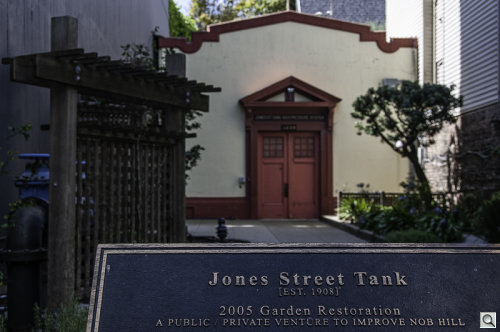Photo Corners headlinesarchivemikepasini.com
![]()
A S C R A P B O O K O F S O L U T I O N S F O R T H E P H O T O G R A P H E R
![]()
Enhancing the enjoyment of taking pictures with news that matters, features that entertain and images that delight. Published frequently.
Friday Slide Show: Jones Street Tank



8 April 2022
We thought we'd take a little break from sitting in on Joyce's hyperbarometric oxygen sessions by taking a walk around the neighborhood. Before we did, though, we used Apple Maps to see what attractions there are to visit.
Apart from the California St. cable car line (which is running pretty infrequently these days), there wasn't much. Sure, there's Nob Hill and Grace Cathedral (which charges admission these days) but we were looking for something more neighborhood-like.
And, this being San Francisco, we found it. In spades. Or, better put, with a spade we were able to dig into the story enough to find out it leads right back to the 1906 earthquake and fire. The fire especially.
Tucked into a small lot on Jones Street is a little building over 100 years old. Built in 1912, the Jones Street Tank is a 750,000 gallon, 35-foot tall tank fronted by a pump house.
It's one of the three sources of water for the San Francisco Fire Department High Pressure System used strictly for fire fighting. That system is supplied by a 10.5 million gallon reservoir on Twin Peaks, the 500,000 gallon Ashbury Tank and the 750,000 gallon Jones Street Tank, all located at high elevations so gravity powers delivery of the water.
The Twin Peaks reservoir connects directly to the Ashbury Tank at 494 feet and that is connected directly to the Jones Street Tank at 369 feet. When Ashbury and Jones are connected, they provide 214 psi water pressure. Otherwise Jones provides 160 psi.

Aerial View. The Spanish tile circle is the actual tank, not easily seen from the street.
They feed the Laurel and Hardy fat pumps in the city whose tops are painted different colors to indicate which tank their water comes from. Black tops are fed by Twin Peaks, red by Ashbury and blue by Jones Street.
There are also skinny, more modern hydrants in the city. If they have a green top, they are fed by one of a system of 177 independent underground cisterns that vary in size from 75,000 to over 200,000 gallons.
And if the auxiliary system runs out of fresh water, fireboats can pump salt water into system.
The system was engineered in response to the failure of the emergency water system during the 1906 disaster. Based on Fire Department Chief Engineer Dennis Sullivan's 1903 proposal and developed by City Engineer Marsden Mason, it was built between 1909 and 1913.
During the 1906 fire, the city's hydrants ran out of water to fight the blaze. Dynamite had to be used along Van Ness to prevent the fire from going further west.
But one hydrant in the city did not fail in 1906. Fed by a spring that, centuries ago, fed Mission Dolores, it kept pumping at Church and 20th Street. In recognition of its role in saving the Mission District, it is painted gold every April 18 on the anniversary of the earthquake.
